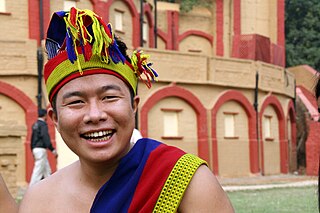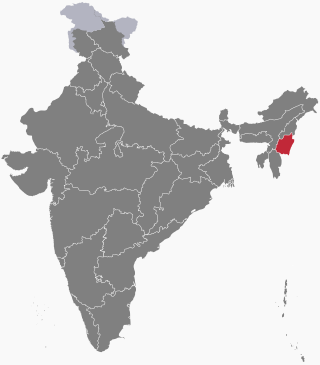
Nagas are various ethnic groups native to northeastern India and northwestern Myanmar. The groups have similar cultures and traditions, and form the majority of population in the Indian state of Nagaland and Naga Self-Administered Zone of Myanmar (Burma); with significant populations in Manipur, Arunachal Pradesh and Assam in India; Sagaing Region and Kachin State in Myanmar.
Anal or Anāl, also known as Pakan Naga, after the two principal villages where it is spoken in, is a Southern Naga language, part of the Sino-Tibetan language family, spoken by the Anal people in India and a dwindling number in Myanmar. It had 83,000 speakers in India according to the 2001 census, and 55,000 in Myanmar in 2010. It has two principal clans, Murchal and Moshum, and is closest to Lamkang. The language of wider communication is Meitei language. The name "Anal" was given by the Meitei people of Manipur valley. Anal is written in the Latin script, with a literacy rate of about 87%.

The Tangkhul people, also known as the Tangkhul Naga, are a Tibeto-Burmese ethnic group living in the Indo–Mayanmar border area, occupying the Ukhrul district and Kamjong district in the Northeast Indian state of Manipur, and in parts of neighboring Myanmar. Despite this international border, many Tangkhul have continued to regard themselves as "one nation". The name "Tangkhul" is originated from the Meitei language words, "Tang" meaning "scarce" and "Khul" meaning "village" respectively. According to another theory of origin, the term "Tangkhul" is derived from "Thankhul", meaning "Than village" in Meitei language.
The Kuki-Chin–Naga languages are a geographic clustering of languages of the Sino-Tibetan family in James Matisoff's classification used by Ethnologue, which groups it under the non-monophyletic "Tibeto-Burman". Their genealogical relationship both to each other and to the rest of Sino-Tibetan is unresolved, but Matisoff lumps them together as a convenience pending further research.
The Naga languages are a geographic and ethnic grouping of languages under the Kuki-Chin-Naga languages, spoken mostly by Naga peoples.
The Tangkhulic and Tangkhul languages are a group of Sino-Tibetan languages spoken mostly in northeastern Manipur, India. Conventionally classified as "Naga," they are not clearly related to other Naga languages, and are conservatively classified as an independent Tangkhul–Maring branch of Tibeto-Burman, pending further research.
The Zemeic, Zeme, Zeliangrong or Western Naga are a languages branch of Sino-Tibetan languages spoken mostly in Indian state of Nagaland, Assam and Manipur in northeast India. It may have close relationship with other Naga languages pending further research. The corresponding ethnic group is the Zeliangrong people. There were 63,529 Zeliang-speaking people in India in 2011.
The Kuki-Chin languages are a branch of 50 or so Sino-Tibetan languages spoken in northeastern India, western Myanmar and southeastern Bangladesh. Most speakers of these languages are known as Mizo in Mizoram and Manipur. Also, as Kukī in Assamese and Bengali and as Chin in Burmese; some also identify as Zomi. Mizo is the most widely spoken of the Kuki-Chin languages. The Kuki-Chin language has official status in both Chin State and Mizoram as Chin and Mizo respectively.

The Tibeto-Burman languages are the non-Sinitic members of the Sino-Tibetan language family, over 400 of which are spoken throughout the Southeast Asian Massif ("Zomia") as well as parts of East Asia and South Asia. Around 60 million people speak Tibeto-Burman languages. The name derives from the most widely spoken of these languages, Burmese and the Tibetic languages, which also have extensive literary traditions, dating from the 12th and 7th centuries respectively. Most of the other languages are spoken by much smaller communities, and many of them have not been described in detail.

Tangkhul is a Sino-Tibetan language of the Tangkhulic branch, spoken in 168 villages of Ukhrul district, Manipur, India. The term "Tangkhul" is derived from the Meitei language terms, "Tang" meaning "scarce" and "Khul" meaning "village" respectively. According to another theory, the term "Tangkhul" is derived from "Thankhul", meaning "Than village" in Meitei language.

Monsang is an unclassified Sino-Tibetan language spoken in the Northeast of India. Scott DeLancey, et al. (2015) classifies Monsang as a "Northwest Naga" language. The speakers of this language use Meitei language as their second language (L2) according to the Ethnologue.

Moyon is a Sino-Tibetan language of Southern Naga linguistic sub branch. It is spoken by the Moyon peoples in Manipur, India and in Burma. The speakers of this language use Meitei language as their second language (L2) according to the Ethnologue.
Sorbung is a recently discovered Sino-Tibetan language spoken in Manipur, northeastern India. Although the speakers are ethnically Tangkhul, it appears to be a non-Tangkhulic Kuki-Chin language, as it shows strong links with what was called 'Southern Tangkhul' in Brown (1837), which was also a non-Tangkhulic language spoke by ethnic Tangkhul.
Somra, also known as Burmese Tangkhul, is a Sino-Tibetan language spoken in Myanmar. The two ethnic Tangkhul languages are related, but are not mutually intelligible, being only 30% lexically similar. Somra is closer to Akyaung Ari.
Koki, or Koki Naga, is an unclassified Sino-Tibetan language spoken in Burma. Speakers are included under the wider Naga ethnicity. It has been documented in Shintani (2018).
Makury, or Makury Naga, is a Naga language of India and Myanmar. Shi (2009:3) and Saul (2005:25) suggest that Makury may be an Ao language. The Makury dialects share 93% lexical similarity.

The Anāl are some of the oldest settlers of the present day Manipur. They belong to the Naga tribe native to Manipur state in North-East India and part of Myanmar. The name "Anal" was given by the Meitei people of Manipur valley. They are listed as a Scheduled Tribe, in accordance with The Scheduled Castes and Scheduled Tribes Orders (Amendment) Act, 1976 Indian Constitution. The Anāl tribe is one of the 'sixty six Naga tribes' of the Naga ancestral homeland. The members of this tribe are found both in India and Myanmar. In India, they are situated in the States of Manipur and Nagaland but mostly concentrated in the former. In the State of Manipur, the Anāl Naga population concentrated in Chandel and a few Anāl villages are located in its neighbouring districts, Churachandpur district has about three villages and Thoubal district has one or two.

The following outline is provided as an overview of and topical guide to Manipur:
The Tangkhul–Maring languages are a small family of Sino-Tibetan languages spoken in eastern Manipur of northeast India and Southwestern Sagaing in Myanmar. Conventionally classified as "Naga", they are not clearly related to other Naga languages, and are conservatively classified as an independent branch of Sino-Tibetan, pending further research.
Maring Naga may refer to:






